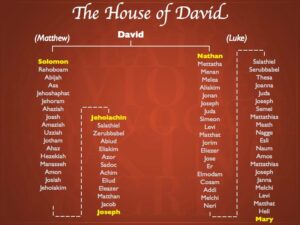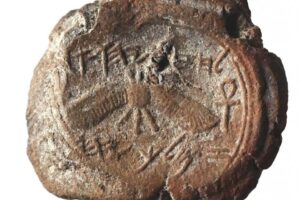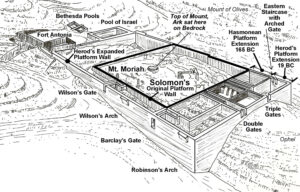Veiled – a Genealogical Fact
Anyone who reads the Matthew and Luke Gospel genealogies of Jesus of Nazareth can easily see they are listed differently – Matthew chronologically works forward starting with Abraham, Luke works backward from Jesus of Nazareth all the way to Adam. Consequently, the variation leads to a controversy where detractors say the lineage inconsistency proves the inaccuracy of the Gospels.[1]
Divergence between the two Gospels occurs in the interim generations between King David and the birth of Jesus. Matthew and Luke genealogy lists have two names in common when they share ancestors at the end of the Babylonian captivity, Zerubbabel, son of Shealtiel.[2]
 Matthew’s genealogy traces back to the House of David through Solomon while Luke tracks the lineage of Jesus back to David’s son Nathan, a different lineage path. Many experts believe Luke’s lineage is that of Mary and was assumed by Joseph under Judaic Law covering her inheritance rights as a Jewish female only-child.[3]
Matthew’s genealogy traces back to the House of David through Solomon while Luke tracks the lineage of Jesus back to David’s son Nathan, a different lineage path. Many experts believe Luke’s lineage is that of Mary and was assumed by Joseph under Judaic Law covering her inheritance rights as a Jewish female only-child.[3]
“Biblical chronology ignores the mother in the lineal descent of generations. The census was conducted “after their families, by the house of their fathers” (Num. §, 2)>.” JewishEncyclopedia.com
Hebrew genealogical records were not just limited to the land of Israel. Jewish historian Josephus wrote they were tracked and recorded by local priests and prophets for all Jews living “at Egypt and at Babylon, or in any other place of the rest of the habitable earth…with the utmost accuracy.”[4]
Maximum religious importance was placed on Hebrew genealogy for the specific purpose of ensuring the purity of the lineage of the priesthood.[5] Proof was required that a female was a Hebrew thus necessitating documented credible lineage history.
To become the wife of a Priest, a Jewish woman was subjected to the scrutiny of her “genealogy from the ancient tables” and Josephus used the historical Hebrew scenario to make his point. After the release of the Jews from Babylonian captivity, 565 priests were disqualified from the priesthood “having married wives whose genealogies they could not produce.”[6]
As a former Priest and Pharisee, Josephus pointed to the Jewish lineage records by challenging anyone who questioned his own heritage to check the public records tracing his family’s ancestry going back 2000 years.[7] This period of years equates to the same time span covering from Jesus back to Abraham.
Genealogies by Hebrew law were readily available in the Temple until it was destroyed by Rome in 70 AD, seven decades after the birth of Jesus. These records had to include Joseph, Mary and the birth of Jesus.[8]
Luke records that Joseph and Mary went “to Jerusalem” and paid a redemption price (implying at the Temple) for a sacrifice for a firstborn male in compliance with the Law.[9] A sacrifice by a priest would not be performed unless the Hebrew lineages of Joseph and Mary were verified.
A truism in the world of investigations is that when information is being intentionally withheld, it is a strong signal to pay attention to it.[12] Direct acknowledgement of the lineage of Jesus by Judaism is rare, practically unspoken – in this case, silence speaks volumes; however, there are a few exceptions.
Talmud Sanhedrin 43a is a tractate that fell victim to the Censor in the Middle Ages. Restored, the missing content strongly infers that Jesus was of royal lineage because he was associated with the government or royalty; therefore, an exception was made for Yeshu (Jesus) from the Jewish Law for blasphemy or idolatry.[10]
Sanhedrin 43a Gemara
“With Yeshu however it was different, for he was connected with the government [or royalty, i.e., influential].’” – Soncino Babylonian translation
“Rather, Jesus was different, as he had close ties with the government…” – William Davidson translation
Rabbi Maimonides, a Jewish sage who lived some 1200 years after the birth of Jesus, produced his renowned work, Mishneh Torah. In it, the Rabbi denounced Jesus as one from the Davidic dynasty who had “aspired” to be the Messiah:[11]
“If he did not succeed to this degree or he was killed, he surely is not [the redeemer] promised by the Torah. [Rather,] he should be considered as all the other proper and legitimate kings of the Davidic dynasty who died. Jesus of Nazareth who aspired to be the Moshiach and was executed by the court…”
Jewish sages agree that prophecies define the virtually undisputed requirement that the Messiah must be born in the lineage of King David. If Jesus of Nazareth was not born in David’s royal lineage, he could not be the Messiah.
Archenemies of Jesus, the Jewish leadership, were at ground zero with full access to the Temple’s complete Hebrew genealogical records dating back millennia. If the High Priest Caiaphas or the Jewish leadership had simply demonstrated that Jesus of Nazareth did not have royal legal rights to the House of David, it would eliminate any doubt that Jesus is the Messiah.
What is the likelihood the archenemies of Jesus would have taken full advantage of the opportunity to disqualify Jesus as the Messiah if they could have just exposed Jesus of Nazareth was not of the royal House of David?
Updated November 26, 2024.
This work is licensed under a Creative Commons Attribution-NonCommercial-NoDerivatives 4.0 International License.
REFERENCES:
[1] Lippard, Jim. The Secular Web. 2004. “The Fabulous Prophecies of the Messiah.” https://infidels.org/library/modern/jim_lippard/fabulous-prophecies.html> “Contradictions Part 6: Jesus’s Genealogy.” Finding Truth. 2011. <https://findingtruth.info/2011/03/11/contradictions-part-6-jesus-genealogy
[2] Matthew 1:1-16; Luke 3:23-38. Dolphin, Lambert. “The Genealogy from Adam to Jesus Christ” Idolphin.org. 2011. <http://ldolphin.org/2adams.html> Edersheim. The Life and Times of Jesus the Messiah. Book II, Chapter 4. <http://philologos.org/__eb-lat/default.htm>
[3] “Paternity.” Jewish Encyclopedia. 2011. <http://jewishencyclopedia.com/articles/11939-paternity> “Historical Commentary: The Birth of Jesus.” Producer John Heyman. Film, Event 3. HistoricJesus.com. <http://www.historicjesus.com/3/history.html> Net.bible.org. Luke 3:23-38 footnotes 69 – 82. Life Application Bible – New International Version (NIV). “The Birth of Jesus” (Luke 2:1-20) History and Commentary.” Tyndale House Publishers, Inc., Wheaton Illinois, and Zondervan Publishing House. 1991, 1790. Ryrie Study Bible. Ed. Ryrie Charles C. Trans. New American Standard. 1978. Matthew 1:1 Luke 3:23 Footnotes. The House of David. Global Empower Media. image. 2012. <http://1.bp.blogspot.com/-_tfUQCGrAsk/UEhE1xBb8ZI/AAAAAAAAH6c/YlnNltTOjcc/s1600/David1.jpg> Edersheim, Alfred. The Life and Times of Jesus the Messiah. 1883. Book II, Chapter 4. Maas, Anthony. “Genealogy of Christ.” Catholic Encyclopedia. 2009. Volume 61909. <http://www.newadvent.org/cathen/06410a.htm> Clarke’s Commentary on the Bible. Luke 3:23. BibleHub.com. n.d. <http://biblehub.com/commentaries/clarke/luke/3.htm> Gloag, Paton J. Introduction to the Synoptic Gospels. Edinburgh: T & T Clark. 1895. “Introduction to the Synoptic Gospels.” Online Books Page. Pages ix, 39. <http://catalog.hathitrust.org/Record/008728595>
[4] Josephus, Flavius. Against Apion. Book 1, #6-7. The Complete Works of Josephus. 1850. <http://books.google.com/books?id=e0dAAAAAMAAJ&printsec=frontcover&source=gbs_ge_summary_r&cad=0#v=onepage&q&f=false> “Genealogy.” Jewish Encyclopedia.
[5] I Chronicles 1:24 – 2:10; II Chronicles 2:1-10; Ruth 4:18-21; Matthew 1:5; Luke 3:32. Josephus. Against Apion. Book 1, #6-7.“Genealogy.” Jewish Encyclopedia. 2011. http://www.jewishencyclopedia.com/articles/6577-genealogy. “Siege of Jerusalem.” Encyclopædia Britannica. 2018. <https://www.britannica.com/event/Siege-of-Jerusalem-70> Josephus, Flavius. Antiquities of the Jews. Book III, Chapter XII.2. The Complete Works of Josephus. 1850. <http://books.google.com/books?id=e0dAAAAAMAAJ&printsec=frontcover&source=gbs_ge_summary_r&cad=0#v=onepage&q&f=false>
[6] Ezra 2:61-62; Nehemiah 7:63-64. Josephus. Antiquity of the Jews. Book XI, Chapter III.10.
[7] Nehemiah 12:23. The Life of Flavius Josephus. #1. CR footnote “t”.
[8] I Chronicles 1:24 – 2:10; II Chronicles 2:1-10; Ruth 4:18-21; Matthew 1:5; Luke 3:32. “Genealogy.” Jewish Encyclopedia. 2011. <http://www.jewishencyclopedia.com/articles/6577-genealogy>> “Siege of Jerusalem.” Encyclopædia Britannica. 2018. <https://www.britannica.com/event/Siege-of-Jerusalem-70>
[9] Luke 2:22-24. “First-born, Redemption of.” Jewish Encyclopedia. 2011. <http://www.jewishencyclopedia.com/articles/6138-first-born-redemption-of> Edersheim. The Life and Times of Jesus the Messiah. Book II, Chapter 7.
[10] Soncino BabylonianTalmud. Ed. Epstein, Isidor. “Introduction to the Seder Nezikin.” Soncino Babylonian Talmud. Shachter & Freedman. “Introduction to Sanhedrin.” Soncino Babylonian Talmud. Sanhedrin Chapter VI, Folio 43a. Greenberg, Eric J. “Jesus’ Death Now Debated by Jews.” Jewish Journal. 2003. Reprinted from The Jewish Week. <http://jewishjournal.com/news/world/8546> Sanhedrin 43a. Sefaria.org. p 21 <https://www.sefaria.org/Sanhedrin.43a.22?lang=bi>
[11] Maimonides, Moses. (aka Rambam.) Mishneh Torah. Ed. Yechezkal Shimon Gutfreund, Brooklyn, NY: Sichos in English. “The Law Concerning Moshiach.” Kesser.org. n.d. <http://www.kesser.org/moshiach/rambam.html#SIE Maimonides. Mishneh Torah. Moznaim Publications. Jewish year 4937 (1177 AD). Trans. Eliyahu Touger. Chabad.org. 2015. “Sefer Shoftim” > “Melachim uMilchamot.” <http://www.chabad.org/library/article_cdo/aid/682956/jewish/Mishneh-Torah.htm
[12] “Deception in Research Guidance.” University of Wisconsin-Madison|KnowledgeBase. 2016. <https://kb.wisc.edu/page.php?id=68286> Sapir, Avinoam. LSI Laboratory for Scientific Interrogation, Inc. n.d. <http://www.lsiscan.com/index.htm “SCAN – Scientific Content Analysis (Statement Analysis).” Advanced Polygraph. 2011. <http://www.advancedpolygraph.com.au/scan.htm Lesce, Tony. “SCAN: Deception Detection by Scientific Content Analysis.” LSI Laboratory for Scientific Interrogations, Inc. 1990. <http://www.lsiscan.com/id37.htm Gordon, Nathan J.; Fleisher, William L. Effective Interviewing and Interrogation Techniques. p12. 2011. <https://books.google.com/books?id=JuMzKpFu93IC&pg=PA86&lpg=PA86&dq=interrogation+if+they+didn%27t+answer+the+question,+they+just+did&source=bl&ots=V4cf3Z1kjl&sig=NeRLKyFKMRr66SWtUQxbLrByKrY&hl=en&sa=X&ved=0ahUKEwi_2Z3phb_aAhVBgK0KHWMQDOA4FBDoAQgtMAE#v=onepage&q=concealing%20information&f=false Napier, Michael R. Behavior, Truth and Deception. 2017. “Nonresponsive Subject.” p56. <https://books.google.com/books?id=eEUrDwAAQBAJ&pg=PT95&lpg=PT95&dq=Sapir+if+they+didn%27t+answer+the+question&source=bl&ots=95gjQFQYg9&sig=gUOEC7Aiq-yFgqUEA4VClHyzNhA&hl=en&sa=X&ved=0ahUKEwjspeHFkr_aAhVwjK0KHab-DF0Q6AEIRjAC#v=onepage&q=nonresponsive&f=false


